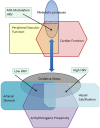Complex nonlinear autonomic nervous system modulation link cardiac autonomic neuropathy and peripheral vascular disease
- PMID: 25870563
- PMCID: PMC4376075
- DOI: 10.3389/fphys.2015.00101
Complex nonlinear autonomic nervous system modulation link cardiac autonomic neuropathy and peripheral vascular disease
Abstract
Background: Physiological interactions are abundant within, and between, body systems. These interactions may evolve into discrete states during pathophysiological processes resulting from common mechanisms. An association between arterial stenosis, identified by low ankle-brachial pressure index (ABPI) and cardiovascular disease (CVD) as been reported. Whether an association between vascular calcification-characterized by high ABPI and a different pathophysiology-is similarly associated with CVD, has not been established. The current study aims to investigate the association between ABPI, and cardiac rhythm, as an indicator of cardiovascular health and functionality, utilizing heart rate variability (HRV).
Methods and results: Two hundred and thirty six patients underwent ABPI assessment. Standard time and frequency domain, and non-linear HRV measures were determined from 5-min electrocardiogram. ABPI data were divided into normal (n = 101), low (n = 67) and high (n = 66) and compared to HRV measures.(DFAα1 and SampEn were significantly different between the low ABPI, high ABPI and control groups (p < 0.05).
Conclusion: A possible coupling between arterial stenosis and vascular calcification with decreased and increased HRV respectively was observed. Our results suggest a model for interpreting the relationship between vascular pathophysiology and cardiac rhythm. The cardiovascular system may be viewed as a complex system comprising a number of interacting subsystems. These cardiac and vascular subsystems/networks may be coupled and undergo transitions in response to internal or external perturbations. From a clinical perspective, the significantly increased sample entropy compared to the normal ABPI group and the decreased and increased complex correlation properties measured by DFA for the low and high ABPI groups respectively, may be useful indicators that a more holistic treatment approach in line with this more complex clinical picture is required.
Keywords: ankle brachial pressure index (ABPI); atherosclerosis; calcification; complex systems; heart rate variability (HRV); network physiology; peripheral vascular disease (PVD).
Figures
References
-
- Applegate W. B. (1993). Ankle/arm blood pressure index. JAMA 270, 497–498. - PubMed
-
- Austin M., Jelinek H. F., Cole K. (2006). Age and gender effect in ankle-brachial-index assessment. Diab. Foot. 9, 93–98.
LinkOut - more resources
Full Text Sources
Other Literature Sources




